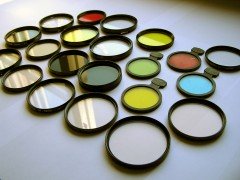
Filters are glass fittings that are used in combination with the camera lens to alter the image being captured. Filters come in various sizes which decide their compatibility. Depending on the type of camera you have your camera may or may not accept filters – all SLRs and some prosumers do.
Depending on the type of filter you are using the filter will have a certain effect on the scene being captured. Filters are used to equalize areas of extreme highlights, reduce haze, reduce the light in the scene or even just to protect the lens.
Filters are of various types and sizes. Here are some of the more prominent types.
-
UV/Skylight Filter
These are colorless filters mostly used to protect the front element of the camera lens – better to loose a filter than scratch a lens. However these filters are also used to cut through the haze and ultra-violet radiation thereby improving the contrast of the scene.
-
Grey graduated filter/ Graduated Neutral Density Filter (GND)
This filter has a slight tint at one end and is clear at the other. This forms a gradient across the filter. The grey graduated filter is used to darken a part of the scene which contains extreme highlights. A good example is a scene where the presence of the sun causes vignetting or alters the metering of the DSLR resulting in a loss of details in the underexposed areas. A graduated filter (simply called ‘grad’) will reduce the intensity of the sun showing through the tinted part while the rest of the image shows through the clear part. This will equalize the light in the overall image thereby allowing better metering and exposure.
-
Neutral Density Filter
Simply referred to as ND, a neutral density filter is uniformly grayish all over and reduces incoming light. It finds use in overly lit scenes where a big aperture is warranted (because of DOF considerations) or where long exposure is warranted to induce motion blur.
-
Polarizing Filter
Polarizers have the most dramatic effect on the scene. Polarizers are used to reduce reflections, cut through haze and increase color saturation in an image. These filters are quite complicated as is their use, so we’ll cover the polarizers in a dedicated article.
While the necessity of using a filter depends on the application it is recommended that you invest in a good quality UV/Skylight filter. As mentioned above, it serves as a lens protection element and is easy and economical to replace than a damaged lens. Which filter do you use the most?


I often use ND filters. I have an ND4 and two ND8, one of them with step-up ring to avoid vignetting. I also use from time to time polarizer. The lenses are covered all the time with UV filters. I preffer the Hoya Pro1D, as they are slim (3mm vs 5mm usual) and they let pass almost all the light. More than that, I think that Hoya gives the best balance between price and quality (compared to other filter makers)